Mealybug
Mealybugs are insects in the family Pseudococcidae, unarmored scale insects found in moist, warm habitats. Of the more than 2000 described species, many are considered pests as they feed on plant juices of greenhouse plants, house plants and subtropical trees and also act as a vector for several plant diseases. Some ants live in symbiotic relationships with them, protecting them from predators and feeding off the honeydew which they excrete.
| Pseudococcidae | |
|---|---|
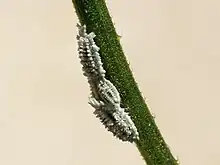 | |
| Mealybugs on a flower stem in Yogyakarta | |
| Scientific classification | |
| Domain: | Eukaryota |
| Kingdom: | Animalia |
| Phylum: | Arthropoda |
| Class: | Insecta |
| Order: | Hemiptera |
| Suborder: | Sternorrhyncha |
| Superfamily: | Coccoidea |
| Family: | Pseudococcidae Heymons, 1915 [1] |
Description
Mealybugs are sexually dimorphic: females appear as nymphs, exhibiting reduced morphology, and lack wings, although unlike many female scale insects, they often retain legs and can move. Males are smaller, gnat-like and have wings. Since mealybugs (as well as all other Hemiptera) are hemimetabolous insects, they do not undergo complete metamorphosis in the true sense of the word. However, male mealybugs do exhibit a radical change during their life cycle, changing from wingless, ovoid nymphs to wasp-like flying adults.
Mealybug females feed on plant sap, normally in roots or other crevices, and in a few cases the bottoms of stored fruit. They attach themselves to the plant and secrete a powdery wax layer (hence the name "mealy" bug) used for protection while they suck the plant juices. In Asia, mango mealybug is considered a major menace for the mango crop. The males on the other hand are short-lived as they do not feed at all as adults and only live to fertilize the females. Male citrus mealy bugs fly to the females and resemble fluffy gnats.
Some species of mealybug lay their eggs in the same waxy layer used for protection in quantities of 50–100; other species are born directly from the female.
The most serious pests are mealybugs that feed on citrus; other species damage sugarcane, grapes, pineapple (Jahn et al. 2003), coffee trees, cassava, ferns, cacti, gardenias, papaya, mulberry, sunflower and orchids. Mealybugs only tend to be serious pests in the presence of ants because the ants protect them from predators and parasites.[2] Mealybugs are also a vector of viruses in grapevines, spreading grapevine leafroll and grapevine red blotch viruses.[3] Mealybugs also infest some species of carnivorous plant such as Sarracenia (pitcher plants); in such cases it is difficult to eradicate them without repeated applications of insecticide such as diazinon. Small infestations may not inflict significant damage. In larger amounts though, they can induce leaf drop. In recent years, some of the mealybug species have become invasive pests in localities posing a great problem to the new agro-ecosystems. In India, Withania somnifera plant have been reported as a new reservoir host for an invasive mealybug species Phenacoccus solenopsis.[4]
Some mealybugs of the Hypogeococcus are used as biological pest controls of invasive cacti in South Africa, including Harrisia balansae, H. martinii, and Opuntia cespitosa.[5]
Fossil specimens of genus Acropyga ants have been recovered from the Burdigalian stage Dominican amber deposits and several individuals are preserved carrying the extinct mealybug genus Electromyrmococcus.[6] These fossils represent the oldest record of the symbiosis between mealybugs and Acropyga species ants.[6]
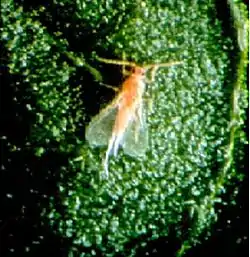 Male hibiscus mealybug, Maconellicoccus hirsutus
Male hibiscus mealybug, Maconellicoccus hirsutus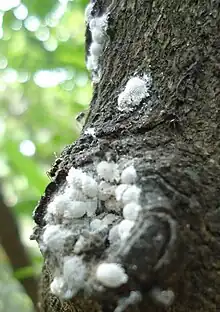 Formica fusca ants tending a herd of mealybugs
Formica fusca ants tending a herd of mealybugs.jpg.webp) A ladybird preying on mealybugs
A ladybird preying on mealybugs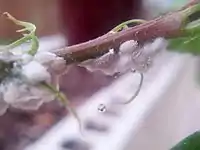 Mealybugs on hibiscus plant
Mealybugs on hibiscus plant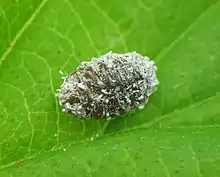 Phenacoccus aceris
Phenacoccus aceris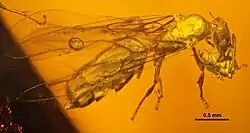 Acropyga glaesaria ant carrying an Electromyrmococcus abductus mealybug
Acropyga glaesaria ant carrying an Electromyrmococcus abductus mealybug
Control methods
Pyrethroids such as permethrin, bifenthrin or cyfluthrin can be used to control mealybugs.[7]
Some gardeners use green lacewing (Chrysopidae) larvae to control mealybug infestations, as the larval lacewings are voracious predators of aphids and other small insects.[8]
Metabolism
Mealybugs have a highly sophisticated metabolism that involves not one but two bacterial endosymbionts, one inside the other. The endosymbionts make essential amino acids that the mealybug is not able to acquire directly from its diet. Genetically, mealybugs rely on a "mosaic" of metabolic pathways in which proteins are transported across membranes between what were once independent organisms.[9]
Genera
- Acaciacoccus
- Acinicoccus
- Acrochordonus
- Adelosoma
- Agastococcus
- Albertinia
- Allomyrmococcus
- Allotrionymus
- Amonostherium
- Anaparaputo
- Anisococcus
- Annulococcus
- Anthelococcus
- Antonina
- Antoninella
- Antoninoides
- Apodastococcus
- Artemicoccus
- Asaphococcus
- Asphodelococcus
- Asteliacoccus
- Atriplicicoccus
- Atrococcus
- Australicoccus
- Australiputo
- Balanococcus
- Bessenayla
- Bimillenia
- Birendracoccus
- Boninococcus
- Boreococcus
- Bouhelia
- Brasiliputo
- Brevennia
- Brevicoccus
- Callitricoccus
- Calyptococcus
- Cannococcus
- Capitisetella
- Cataenococcus
- Chaetococcus
- Chaetotrionymus
- Chileputo
- Chlorococcus
- Chnaurococcus
- Chorizococcus
- Chryseococcus
- Cintococcus
- Circaputo
- Cirnecoccus
- Clavicoccus
- Coccidohystrix
- Coccura
- Coleococcus
- Colombiacoccus
- Conicosoma
- Conulicoccus
- Coorongia
- Cormiococcus
- Criniticoccus
- Crisicoccus
- Crocydococcus
- Cryptoripersia
- Cucullococcus
- Cyperia
- Cypericoccus
- Cyphonococcus
- Dawa
- Delococcus
- Delottococcus
- Densispina
- Discococcus
- Distichlicoccus
- Diversicrus
- Drymococcus
- Dysmicoccus
- Eastia
- Ehrhornia
- Electromyrmococcus †
- Epicoccus
- Erimococcus
- Eriocorys
- Erioides
- Erium
- Eucalyptococcus
- Eumirococcus
- Eumyrmococcus
- Eupeliococcus
- Euripersia
- Eurycoccus
- Exilipedronia
- Farinococcus
- Ferrisia
- Ferrisicoccus
- Fijicoccus
- Fonscolombia
- Formicococcus
- Gallulacoccus
- Geococcus
- Glycycnyza
- Gomezmenoricoccus
- Gouxia
- Greenoripersia
- Grewiacoccus
- Hadrococcus
- Heliococcus
- Heterococcopsis
- Heterococcus
- Heteroheliococcus
- Hippeococcus
- Hopefoldia
- Humococcus
- Hypogeococcus[5]
- Iberococcus
- Idiococcus
- Indococcus
- Inopicoccus
- Ityococcus
- Kenmorea
- Kermicus
- Kiritshenkella
- Lachnodiella
- Lachnodiopsis
- Lacombia
- Laingiococcus
- Laminicoccus
- Lankacoccus
- Lantanacoccus
- Lenania
- Leptococcus
- Leptorhizoecus
- Liucoccus
- Lomatococcus
- Londiania
- Longicoccus
- Maconellicoccus
- Macrocepicoccus
- Maculicoccus
- Madacanthococcus
- Madagasia
- Madangiacoccus
- Madeurycoccus
- Malaicoccus
- Malekoccus
- Mammicoccus
- Marendellea
- Mascarenococcus
- Maskellococcus
- Mauricoccus
- Melanococcus
- Metadenopsis
- Metadenopus
- Miconicoccus
- Mirococcopsis
- Mirococcus
- Miscanthicoccus
- Misericoccus
- Mizococcus
- Mollicoccus
- Mombasinia
- Moystonia
- Mutabilicoccus
- Nairobia
- Natalensia
- Neochavesia
- Neoclavicoccus
- Neoripersia
- Neosimmondsia
- Neotrionymus
- Nesococcus
- Nesopedronia
- Nesticoccus
- Nipaecoccus
- Novonilacoccus
- Octococcus
- Odacoccus
- Ohiacoccus
- Oracella
- Orococcus
- Orstomicoccus
- Oxyacanthus
- Palaucoccus
- Palmicultor
- Paludicoccus
- Pandanicola
- Papuacoccus
- Paracoccus
- Paradiscococcus
- Paradoxococcus
- Paraferrisia
- Paramococcus
- Paramonostherium
- Paramyrmococcus
- Parapaludicoccus
- Parapedronia
- Paraputo
- Pararhodania
- Paratrionymus
- Parkermicus
- Paulianodes
- Pedrococcus
- Pedronia
- Peliococcopsis
- Peliococcus
- Pelionella
- Pellizzaricoccus
- Penthococcus
- Peridiococcus
- Phenacoccus
- Phyllococcus
- Pilococcus
- Planococcoides
- Planococcus
- Pleistocerarius
- Plotococcus
- Poecilococcus
- Polystomophora
- Porisaccus
- Porococcus
- Prorhizoecus
- Prorsococcus
- Pseudantonina
- Pseudococcus
- Pseudorhizoecus
- Pseudorhodania
- Pseudoripersia
- Pseudotrionymus
- Puto
- Pygmaeococcus
- Quadrigallicoccus
- Rastrococcus
- Renicaula
- Rhizoecus
- Rhodania
- Ripersia
- Ritsemia
- Rosebankia
- Saccharicoccus
- Sarococcus
- Scaptococcus
- Seabrina
- Serrolecanium
- Seyneria
- Spartinacoccus
- Sphaerococcus
- Spilococcus
- Spinococcus
- Stachycoccus
- Stemmatomerinx
- Stipacoccus
- Strandanna
- Stricklandina
- Strombococcus
- Synacanthococcus
- Syrmococcus
- Tangicoccus
- Tasmanicoccus
- Telocorys
- Tibetococcus
- Tomentocera
- Trabutina
- Tridiscus
- Trimerococcus
- Trionymus
- Trochiscococcus
- Turbinococcus
- Tylococcus
- Tympanococcus
- Ventrispina
- Villosicoccus
- Volvicoccus
- Vryburgia
- Xenococcus
- Yudnapinna
References
- "Pseudococcidae Heymons, 1915". Integrated Taxonomic Information System.
- Noe, Ronald (November 21, 2012). "Fire Ants Protect Mealybugs against Their Natural Enemies by Utilizing the Leaf Shelters Constructed by the Leaf Roller Sylepta derogata". PLOS ONE. US National Library of Medicine National Institutes of Health. 7 (11): e49982. Bibcode:2012PLoSO...749982Z. doi:10.1371/journal.pone.0049982. PMC 3503828. PMID 23185505.
- Bettiga, Larry J (8 September 2015). "Assessing Grapevine Leafroll and Red Blotch Disease Impacts in Local Vineyards". ANR Blogs. Salinas Valley Agriculture. Retrieved 23 December 2022.
- Sharma, A.; Pati, P. K. (2013). "First record of Ashwagandha as a new host to the invasive mealybug (Phenacoccus solenopsis Tinsley) in India". Entomological News. 123 (1): 59–62. doi:10.3157/021.123.0114. S2CID 85645762.
- "Cactus control in the Klein Karoo". Rhodes University. 2014-09-17. Retrieved 2021-04-19.
- Johnson, M.S.; et al. (2001). "Acropyga and Azteca Ants (Hymenoptera: Formicidae) with Scale Insects (Sternorrhyncha: Coccoidea): 20 Million Years of Intimate Symbiosis". American Museum Novitates (3335): 1–18. doi:10.1206/0003-0082(2001)335<0001:AAAAHF>2.0.CO;2. S2CID 55067700.
- SP290-S-Mealybugs on Ornamentals (Report). The University of Tennessee Agricultural Extension Service. 2003. SP290S-1.5M-5/03(Rev) E12-4615-00-030-03.
- "Cryptolaemus and lacewings for mealybug and scale control" (PDF). Department of Primary Studies, NSW. New South Wales. Retrieved 25 May 2021.
- Callier, Viviane (8 June 2022). "Mitochondria and the origin of eukaryotes". Knowable Magazine. doi:10.1146/knowable-060822-2. Retrieved 18 August 2022.
Further reading
- Jahn, G. C. and J. W. Beardsley (1994). "Big-headed ants, Pheidole megacephala: Interference with the biological control of gray pineapple mealybugs". In D.F. Williams [ed.] Exotic Ants: Biology, Impact and Control of Introduced Species. Boulder, Col.: Westview Press, 199–205. ISBN 9780813386157.
- Jahn, G. C. and J. W. Beardsley (1998). "Presence/absence sampling of mealybugs, ants, and major predators in pineapple". J. Plant Protection in the Tropics 11(1):73–79.
- Jahn, Gary C., J. W. Beardsley, and H. González-Hernández (2003). "A review of the association of ants with mealybug wilt disease of pineapple". Proceedings of the Hawaiian Entomological Society. 36:9–28.
External links
- NCIPM (National Centre for Integrated Pest Management) – Cotton Mealybugs
- Mealy bugs Pseudococcus spp.—BBC gardening advice
- CISR – Vine Mealybug—Center for Invasive Species Research summary on Vine Mealybug
- On the University of Florida / Institute of Food and Agricultural Sciences Featured Creatures website: